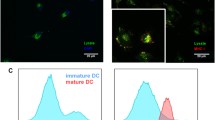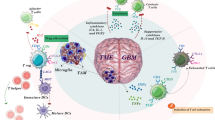Abstract
For adoptively transferred lymphocytes to exert anti-tumor effects in vivo, they must traffic or initiate the migration of endogenous immune cells to the site of tumor. Using a rat model, we examined the trafficking of tumor-sensitized lymphocytes to an intracerebral glioma. By labeling the cells with 111Indium oxine (111In) prior to intravenous injection, we were able to quantify the relative number of lymphocytes that traveled to the tumor site. There was no difference in lymphocytic influx between the tumor-bearing and non-tumor-bearing cerebral hemispheres in 3-day rat glioma models. However, in 7-day models, significantly greater numbers of 111In-labeled lymphocytes resided in the tumor-bearing hemisphere at 12 h post-administration. This number increased more than two-fold by 24 h post-adoptive transfer. Using fluorescent-labeled lymphocytes and microscopy, we confirmed that the detection of radioactivity within the brain was truly due to tumor infiltrating 111In-labeled lymphocytes. Adoptively transferred cells were found in perivascular and peritumoral locations. These data demonstrate that tumor-sensitized lymphocytes traffic to an intracerebral target site where they can exert an effect, further supporting adoptive immunotherapy as a treatment for glioma.
Similar content being viewed by others
References
Rossi ML, Hughes JT, Esiri MM, Coakham HB, Brownell DB: Immunohistological study of mononuclear cell infiltrate in malignant gliomas. Acta Neuropathol (Berl) 74: 269–277, 1987
Shinonaga M, Chang CC, Suzuki N, Sato M, Kuwabara T: Immunohistological evaluation of macrophage infiltrates in brain tumors: correlation with peritumoral edema. J Neurosurg 68: 259–265, 1988
Stevens A, Kloter I, Roggendorf W: Inflammatory infiltrates and natural killer cell presence in human brain tumors. Cancer 61: 738–743, 1988
Farmer J-P, Antel JP, Freedman M, Cashman, NR, Rode H, Villemure JG: Characterization of lymphoid cells isolated from human gliomas. J Neurosurg 71: 528–533, 1989
Kuppner MC, Hamou M-F, de Tribolet N: Immunohistological and functional analyses of lymphoid infiltrates in human glioblastoma. Cancer Res 48: 6926–6932, 1988b
Paine JT, Handa H, Yamasaki T, Yamashita J, Miyatake S: Immunohistochemical analysis of infiltrating lymphocytes in central nervous system tumors. Neurosurgery 18: 766–772, 1986
Tzeng J-J, Barth RF, Orosz CG, James SM: Phenotype and functional activity of tumor-infiltrating lymphocytes isolated from immunogenic and nonimmunogenic rat brain tumors, Cancer Res 51: 2373–2378, 1991
Kuppner MC, Hamou M-F, de Tribolet N: Activation and adhesion molecule statement on lymphoid infiltrates in human glioblastomas. J Neuroimmunol 29: 229–238, 1990
Kjaergaard J, Shu S: Tumor infiltration by adoptively transferred T cells is independent of immunologic specificity but requires down-regulation of L-selectin statement. J Immunol 163: 751–759, 1999
Rabinowich H, Cohen R, Bruderman I, Steiner Z, Klajman A: Functional analysis of mononuclear cells infiltrating into tumors: lysis of autologous human tumor cells by cultured infiltrating lymphocytes. Cancer Res 47: 173–177, 1987
Kuppner MC, Hamou MF, Bodmer S, Fontana A, de Tribolet N: The glioblastoma derived T cell suppressor factor/transforming growth factor-â2 inhibits the generation of lymphokine activated killer (LAK) cells. Int J Cancer 42: 562–567, 1988a
Kuppner MC, Hamou M-F, Sawamura Y, Bodmer S, de Tribolet N: Inhibition of lymphocyte function by glioblastoma-derived transforming growth factor â2. J Neurosurg 71: 211–217, 1989
Fabry Z, Topham DJ, Fee D, Herlein J, Carlino JA, Hart MN, Sriram S: TGF-â2 decreases migration of lymphocyte in vitro and homing of cells into the central nervous system in vivo. J Immunol 155: 325–332, 1995
Male D, Pryce G, Hughes C, Lantos P: Lymphocyte migration into brain modelled in vitro: control by lymphocyte activation, cytokines, and antigen. Cell Immunol 127: 1–11, 1990
Male D, Pryce G, Linke A, Rahman J: Lymphocyte migration into the CNS modelled in vitro. J Neuroimmunol 40: 167–172, 1992
Hickey WF, Hsu BL, Kimura H: T-lymphocyte entry into the central nervous system. J Neurosci Res 28: 254–260, 1991
Kruse CA, Kong Q, Schiltz DM, Kleinschmidt-DeMasters BK: Migration of activated lymphocytes when adoptively transferred into cannulated rat brain. J Neuroimmunol 55: 11–21, 1994
Kuppner MC, Hamou M-F, de Tribolet N: Immunohistological and functional analyses of lymphoid infiltrates in human glioblastoma. Cancer Res 48: 6926–6932, 1988b
Merchant RE, Baldwin NG, Rice CD, Bear HD: Adoptive immunotherapy of malignant glioma using tumor-sensitized T lymphocytes. Neurol Res 19: 145–152, 1997
Beckman WC, Powers SK, Brown JT, Gillespie GY, Bigner DD, Camps JL: Differential retention of rhodamine-123 by avian sarcoma virus-induced glioma and normal brain tissue of the rat in vivo. Cancer 59: 266–270, 1987
Watts RG, Merchant RE: Cerebrovascular effects and tumor kinetics after a single intratumoral injection of human binant interleukin-2 alone or in combination with intravenous chemotherapy in a rat model of glioma. Neurosurgery 31: 89–99, 1992
Baldwin NG, Rice CD, Tuttle TM, Bear HD, Hirsch JI, Merchant RE: Ex vivo expansion of tumor-draining lymph node cells using compounds which activate intracellular signal transduction. I. Characterization and in vivo antitumor activity of glioma-sensitized lymphocytes. J Neuro-Oncol 32: 19–28, 1997
Rice CD, Baldwin NG, Biron RT, Bear HD, Merchant RE: Ex vivo expansion of tumor-draining lymph node cells using compounds which activate intracellular signal transduction. II. Cytokine production and in vivo efficacy of gliomasensitized lymphocytes. J Neuro-Oncol 32: 29–38, 1997
Loeffler D, Ratner S: In vivo localization of lymphocytes labelled with low concentrations of Hoechst 33342. J Immunol Meth 119: 95–101, 1989
Castronovo FP: Animal models in tracer investigationsnormal and modified. In: Glenn HJ (ed) Biologic Applications of Radiotracers. CRC Press, Boca Raton, FL, 1982, pp 1–26
Garcia AM, Gagne GM, Ames IH, Stiteler W, Tomar RH, McAfee JG: Migratory patterns of different Indium-111 labeled leukocyte populations (chiefly lymphocytes) from control and thymectomized rats. J Nucl Med 29: 83–90, 1988
Wiltrout RH, Gorelik E, Brunda MJ, Holden HT, Herberman RB: Assessment of in vivo natural antitumor resistance and lymphocyte migration in mice: comparison of 125I-iododeoxyuridine with 111indium-oxine and 51chromium as cell labels. Cancer Immunol Immunother 14: 172–179, 1983
Butcher EC: The regulation of lymphocyte traffic. Curr Top Microbiol Immunol 128: 85–122, 1986
Butcher EC, Williams M, Youngman K, Rott L, Briskin M: Lymphocyte trafficking and regional immunity. Adv Immunol 72: 209–253, 1999
De Boer AG, Breimer DD: The blood-brain barrier: clinical implications for drug delivery to the brain. J Royal Col Phys London 28: 502–506, 1994
Greenwood J: Mechanisms of blood-brain barrier breakdown. Neuroradiol 33: 95–100, 1991
Stewart DJ: A critique of the role of the blood-brain barrier in the chemotherapy of human brain tumors. J Neuro-Oncol 20: 121–139, 1994
Broadwell RD, Charlton HM, Ebert P, Hickey WF, Villegas JC, Wolf AL: Angiogenesis and the blood-brain barrier in solid and dissociated cell grafts within the CNS. Prog Brain Res 82: 95–101, 1990
Lassmann H, Rossler K, Zimprich F, Vass K: Statement of adhesion molecules and histocompatibility antigens at the blood-brain barrier. Brain Pathol 1: 115–123, 1991
Alexandroff AB, McIntyre CA, Proter JC, Zeuthen J, Vile RG, Taub DD: Sticky and smelly issues: lessons on tumour cell and leucocyte trafficking, gene and immunotherapy of cancer. Br J Cancer 77: 1806–1811, 1998
Author information
Authors and Affiliations
Rights and permissions
About this article
Cite this article
Hazelrigg, M.R., Hirsch, J.I. & Merchant, R.E. Distribution of Adoptively Transferred, Tumor-sensitized Lymphocytes in the Glioma-bearing Rat. J Neurooncol 60, 143–150 (2002). https://doi.org/10.1023/A:1020684732685
Issue Date:
DOI: https://doi.org/10.1023/A:1020684732685




